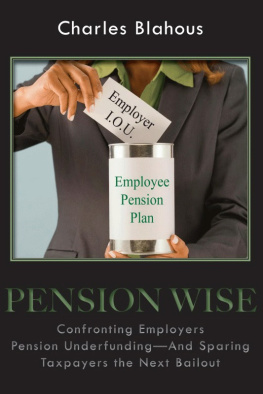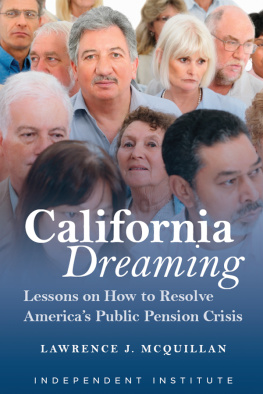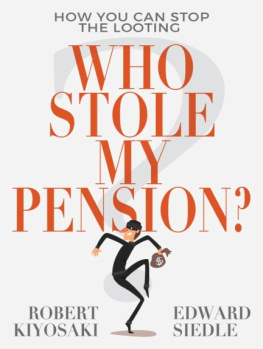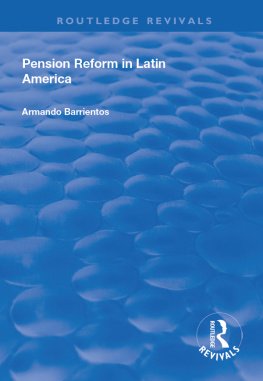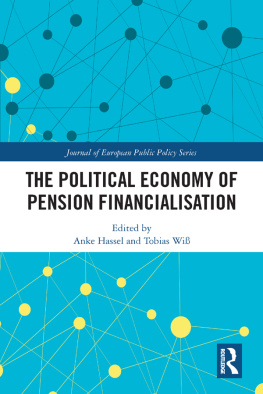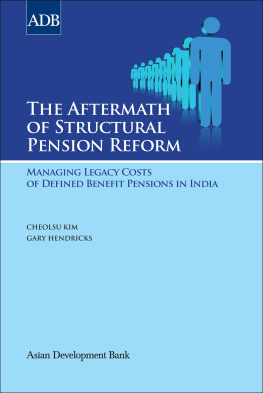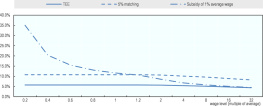The Hoover Institution gratefully acknowledges PAUL H. AND ELISABETH E. BAUER for their significant support of this publication.
PENSION WISE
Confronting Employer Pension UnderfundingAnd Sparing Taxpayers the Next Bailout
Charles P. Blahous
HOOVER INSTITUTION PRESS
Stanford University
Stanford, California
The Hoover Institution on War, Revolution and Peace, founded at Stanford University in 1919 by Herbert Hoover, who went on to become the thirty-first president of the United States, is an interdisciplinary research center for advanced study on domestic and international affairs. The views expressed in its publications are entirely those of the authors and do not necessarily reflect the views of the staff, officers, or Board of Overseers of the Hoover Institution.
www.hoover.org
Hoover Institution Press Publication No. 597
Hoover Institution at Leland Stanford Junior University, Stanford, California, 94305-6010
Copyright 2011 by the Board of Trustees of the Leland Stanford Junior University
All rights reserved. No part of this publication may be reproduced, stored in a retrieval system, or transmitted in any form or by any means, electronic, mechanical, photocopying, recording, or otherwise, without written permission of the publisher and copyright holders.
Hoover Institution Press has no responsibility for the persistence or accuracy of URLs for external or third-party internet websites referred to in this publication, and can not guarantee that any content on such websites is, or will remain, accurate or appropriate.
First printing 2011
17 16 15 14 13 12 11 8 7 6 5 4 3 2 1
Manufactured in the United States of America
The paper used in this publication meets the minimum Requirements of the American National Standard for Information SciencesPermanence of Paper for Printed Library Materials, ANSI/NISO Z39.48-1992.
Cataloguing-in-Publication Data is available from the Library of Congress.

ISBN 978-0-8179-1214-7 (cloth. : alk. paper)
ISBN 978-0-8179-1216-1 (e-book)
LIST OF FIGURES AND TABLES
Figures
Tables
ACKNOWLEDGMENTS
THE AUTHOR WISHES to thank Shengzhi Li for his research contributions to this paper as well as for assistance in editing and formatting the work. Thanks more generally are due to the Woodrow Wilson International Center for Scholars, which not only provided generous support for the research underlying this publication but also provided an ideal environment for bringing this effort to fruition.
Many thanks to John Raisian and the Hoover Institution for their assistance in turning this research project into a published book. Once again I have benefited from the fine efforts of Hoovers many talented professionals, including Barbara Arellano, Marshall Blanchard, Tess Evans, Sarah Farber, Shana Farley, Stephen Langlois, LaNor Maune, Jennifer Navarrette, Christie Parell, Jennifer Presley, Julie Ruggiero, Eryn Witcher, and Ann Wood. As with my previous book, I owe an especial thanks to Barbara Egbert, who worked expertly and expeditiously to refine my original draft through her edits.
Thanks also belong to Donald Marron and Jeffrey Brown for their invaluable insights, which considerably improved the final text of this monograph. The final interpretations, most especially any flaws therein, are my own.
ABSTRACT
AMERICAS INSURANCE SYSTEM for single-employer pension plans, operated by the Pension Benefit Guaranty Corporation (PBGC), is under serious financial strain. In its latest annual report, the PBGC announced a projected deficit in its single-employer pension program of roughly $21 billion in present value. PBGCs worsening deficit reflects, in part, current financial market conditions. It also, however, reflects inadequacies in our pension insurance system that predate the recent economic recession.
The projected shortfall of the pension insurance system is a manifestation of flaws in the federal statutes governing it. These statutes determine both the level of required contributions to pension plans and the amount of premiums paid by pension plan sponsors. Contribution requirements are a function of the measured assets and liabilities of pension plans, specifically of the measured gap between them. Although the 2006 Pension Protection Act (PPA) improved such measurements in several important respects, persistent measurement inaccuracy continues to interfere with informed value judgments as to the contributions that should be required to fill funding shortfalls. Moreover, Congress continues to experience pressure to provide still further funding relief to plan sponsors through the vehicle of more distorted measurements of both assets and liabilities.
Behind the technical reasons for pension plan underfunding are factors that lie in the realms of incentives and political economy. The existence of a pension insurance system itself introduces moral hazard, reducing incentives for employers to fully fund their pension promises as well as reducing incentives for workers to verify that their pensions are fully funded. Moral hazard is also present in the political process that currently governs pension contribution requirements and premium assessments. Elected officials face substantial incentives to value the near-term financial considerations of employers and pension beneficiaries above the long-term fiscal health of the pension insurance system. There is a direct and predictable relationship between these problematic incentives and the failure of existing law to provide for adequately funded pensions.
I recommend that pension plan assets and liabilities be measured, to the extent practicable, using up-to-date market values. Volatility in required contributions should be limited via the contribution rules, rather than by willfully engaging in asset/liability measurement inaccuracy. Pension plan liabilities should be discounted with interest rates that reflect the degree of risk associated with pension benefits. Specifically, if private-sector pension promises are implicitly subsidized by the U.S. taxpayer, then for funding purposes those liabilities should be discounted at Treasury bond rates.
Current loopholes in the law that allow sponsors of underfunded pensions to skip contributions, increase benefits, or pay lump sums without financing these expenditures up front should be limited or, ideally, closed. Provisions that provide preferential treatment to politically influential industries should also be eliminated. The PPA limited many of these problematic features, but further improvements are needed.

